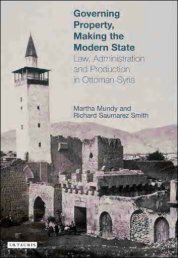The Invention of Tradition as Public Image in the Late ... - PSI424
The Invention of Tradition as Public Image in the Late ... - PSI424
The Invention of Tradition as Public Image in the Late ... - PSI424
You also want an ePaper? Increase the reach of your titles
YUMPU automatically turns print PDFs into web optimized ePapers that Google loves.
INVENTING TRADITION AS PUBLIC IMAGE II<br />
Rose Chamber, (Hat-i Serif-i Giilhane). Even while sett<strong>in</strong>g out <strong>the</strong> re<strong>as</strong>ons for<br />
<strong>the</strong> new laws, <strong>the</strong> declaration b<strong>as</strong>ed itself quite deliberately on religious<br />
dogma, stat<strong>in</strong>g that "it is evident that countries not governed by <strong>the</strong> laws <strong>of</strong><br />
<strong>the</strong> 5eriat cannot prevail."35 Yet, what it decreed w<strong>as</strong> very much aga<strong>in</strong>st <strong>the</strong><br />
5eriat, that is, <strong>the</strong> legal equality <strong>of</strong> Muslim and non-Muslim. In <strong>the</strong> same<br />
ve<strong>in</strong>, <strong>the</strong> document declared that tax <strong>as</strong>sessment and collection would be<br />
carried out accord<strong>in</strong>g to rational methods, on an equitable b<strong>as</strong>is. This appeal<br />
to modernity w<strong>as</strong>, however, couched <strong>in</strong> <strong>the</strong> language <strong>of</strong> <strong>the</strong> cl<strong>as</strong>sic Islamic<br />
image <strong>of</strong> <strong>the</strong> "Circle <strong>of</strong> Equity": Just laws make for prosperous subjects,<br />
prosperous subjects pay <strong>the</strong>ir taxes, taxes pay for soldiers, soldiers protect <strong>the</strong><br />
taxpayers, and so on.36 Thus, although it heralded noth<strong>in</strong>g less than <strong>the</strong><br />
beg<strong>in</strong>n<strong>in</strong>gs <strong>of</strong> a moder secular state, <strong>the</strong> language used w<strong>as</strong> that <strong>of</strong> Islamand<br />
with good re<strong>as</strong>on. <strong>The</strong> me<strong>as</strong>ure <strong>of</strong> legal equality w<strong>as</strong> clearly unpopular<br />
among Muslim subjects, who felt that <strong>the</strong>ir <strong>as</strong>sured place <strong>of</strong> superiority <strong>in</strong> <strong>the</strong><br />
empire w<strong>as</strong> lost.37<br />
In some ways what Abdiilhamid II felt w<strong>as</strong> this very pulse <strong>of</strong> "despondency"<br />
among his Muslim subjects:<br />
<strong>The</strong> old Sultan had certa<strong>in</strong>ly a difficult problem to face <strong>in</strong> <strong>the</strong> earlier years <strong>of</strong> his reign.<br />
In 1880 to 1882 a hopeless despondency about <strong>the</strong> future <strong>of</strong> <strong>the</strong> country reigned<br />
everywhere <strong>in</strong> Turkish society . . . Abd-ul-Hamid had to create a feel<strong>in</strong>g <strong>of</strong> hope<br />
among his Moslem subjects . . . Abd-ul-Hamid <strong>in</strong>troduced <strong>the</strong> new religious idea: he<br />
revived <strong>the</strong> idea <strong>of</strong> <strong>the</strong> khalifate . .. [<strong>as</strong> a scheme for] streng<strong>the</strong>n<strong>in</strong>g Mohammedan<br />
feel<strong>in</strong>g and mak<strong>in</strong>g Turkey <strong>the</strong> center <strong>of</strong> Mohammedan revival.38<br />
In fur<strong>the</strong>r<strong>in</strong>g this aim, <strong>the</strong> person <strong>of</strong> <strong>the</strong> sultan w<strong>as</strong> made to acquire a certa<strong>in</strong><br />
"aura <strong>of</strong> sacrality." This stretched to <strong>the</strong> extent that <strong>the</strong> hair and f<strong>in</strong>gernails <strong>of</strong><br />
<strong>the</strong> august person were saved, w<strong>as</strong>hed <strong>in</strong> silver conta<strong>in</strong>ers by specifically<br />
appo<strong>in</strong>ted servants, and sent to <strong>the</strong> Hicaz every year, <strong>as</strong> part <strong>of</strong> <strong>the</strong> ceremonial<br />
caravan, <strong>the</strong> siirre alayi, which bore <strong>the</strong> annual gifts to <strong>the</strong> Holy Places.39<br />
Yet, <strong>as</strong> <strong>in</strong> <strong>the</strong> c<strong>as</strong>es above, this accompanied <strong>the</strong> effort to be like o<strong>the</strong>r<br />
moder rulers. Friday prayer had always been an important ceremonial occa-<br />
35 Diistur (Register <strong>of</strong> Ottoman Laws) 1.Tertip Istanbul Matbaa-i Amire 1289. (Istanbul<br />
Imperial Press 1289/1872), p. 4.<br />
See also J. C. Hurewitz, <strong>The</strong> Middle E<strong>as</strong>t and Africa <strong>in</strong> World Politics (New Haven, 1975),<br />
269-71. My version differs slightly from that <strong>of</strong> Hurewitz, <strong>in</strong> that I have preferred to use<br />
"prevail" where Hurewitz uses "survive (payidar)". For a good overall description <strong>of</strong> <strong>the</strong><br />
Ottoman reform process known <strong>as</strong> <strong>the</strong> Tanzimat, or re-order<strong>in</strong>g, see Bernard Lewis, <strong>The</strong> Emergence<br />
<strong>of</strong> Modern Turkey (London, 1971).<br />
36 Diistur, p. 5.<br />
37 Moshe Ma'oz, Ottoman Reform <strong>in</strong> Syria and Palest<strong>in</strong>e (Oxford, 1968), 23. Ma'oz states<br />
that differ<strong>in</strong>g versions were circulated <strong>in</strong> <strong>the</strong> Arab prov<strong>in</strong>ces. <strong>The</strong>se were not quite <strong>as</strong> explicit <strong>in</strong><br />
<strong>the</strong>ir declarations <strong>of</strong> equality. On <strong>the</strong> disturbances <strong>in</strong> <strong>the</strong> prov<strong>in</strong>ces, see Serif Mard<strong>in</strong>, <strong>The</strong> Genesis<br />
<strong>of</strong> Young Ottoman Thought (Pr<strong>in</strong>ceton, 1962).<br />
38 William Ramsay Mitchell, "<strong>The</strong> Intermixture <strong>of</strong> Races <strong>in</strong> Asia M<strong>in</strong>or," Proceed<strong>in</strong>gs <strong>of</strong> <strong>the</strong><br />
British Academy 1915-16, pp. 359-422. I owe thanks to Pr<strong>of</strong>essor Serif Mard<strong>in</strong> for this<br />
reference.<br />
39 S<strong>in</strong>a Ak<strong>in</strong>, Tiirkiye Tarihi II (Istanbul, 1988), 8.<br />
This content downloaded from 194.27.149.45 on Wed, 15 May 2013 04:39:11 AM<br />
All use subject to JSTOR Terms and Conditions












